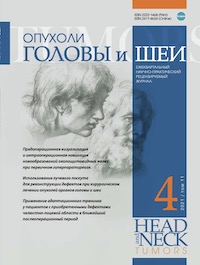Utility of radial flaps for defect repair after surgical excision of head and neck tumors
- Authors: Kropotov M.A.1, Sobolevsky V.A.1, Yakovleva L.P.2, Khodos A.V.2, Saprina O.A.1, Safarov D.A.1
-
Affiliations:
- N.N. Blokhin National Medical Research Center of Oncology, Ministry of Health of Russia
- A.S. Loginov Moscow Clinical Scientific Center of the Moscow Healthcare Department
- Issue: Vol 11, No 4 (2021)
- Pages: 22-28
- Section: DIAGNOSIS AND TREATMENT OF HEAD AND NECK TUMORS
- Published: 14.12.2021
- URL: https://ogsh.abvpress.ru/jour/article/view/711
- DOI: https://doi.org/10.17650/2222-1468-2021-11-4-22-28
- ID: 711
Cite item
Full Text
Abstract
Introduction. Surgery at the first stage has always been the gold-standard treatment for locally advanced head cancer of almost all locations. Such patients often have significant postoperative defects that cause serious functional and aesthetic disorders. This requires simultaneous defect repair. The technique of defect repair should be chosen carefully with the consideration of its benefits and potential consequences.
Objective – to evaluate the efficacy of revascularized radial flaps for defect repair after combination extensive surgical excisions of head and neck tumors.
Materials and methods. This study included 67 patients with head and neck cancers of different locations who had undergone surgical tumor excision followed by defect repair using a radial flap.
Results. All patients had their defects repaired using radial autologous grafts. Since this study included primarily patients with oral and oropharyngeal tumors (53 patients), we also analyzed the survival in this cohort. patients were followed-up for 2 to 7 years. fourteen patients (26.4 %) developed progressive disease during this time, including 8 individuals with recurrent primary tumor and 6 individuals with regional metastases. The mean time to nasoesophageal probe removal and restored swallowing was 12.2 days; mean length of hospital stay was 13.5 days.
Conclusion. Thus, radial flap is a reliable and multifunctional material that can be used to repair complex and combination defects in patients with head and neck tumors. In some cases, it is the method of choice, since it helps to achieve satisfactory quality of life. Repair of tongue defects with radial flaps ensures good functional results.
About the authors
M. A. Kropotov
N.N. Blokhin National Medical Research Center of Oncology, Ministry of Health of Russia
Author for correspondence.
Email: drkropotov@mail.ru
ORCID iD: 0000-0002-9132-3416
Mikhail Alekseevich Kropotov
23 Kashirskoe Shosse, Moscow 115478
Russian FederationV. A. Sobolevsky
N.N. Blokhin National Medical Research Center of Oncology, Ministry of Health of Russia
Email: fake@neicon.ru
ORCID iD: 0000-0003-3668-0741
23 Kashirskoe Shosse, Moscow 115478
Russian FederationL. P. Yakovleva
A.S. Loginov Moscow Clinical Scientific Center of the Moscow Healthcare Department
Email: fake@neicon.ru
ORCID iD: 0000-0002-7356-8321
86 Shosse Entuziastov, Moscow 111123
Russian FederationA. V. Khodos
A.S. Loginov Moscow Clinical Scientific Center of the Moscow Healthcare Department
Email: fake@neicon.ru
ORCID iD: 0000-0001-5706-912X
86 Shosse Entuziastov, Moscow 111123
Russian FederationO. A. Saprina
N.N. Blokhin National Medical Research Center of Oncology, Ministry of Health of Russia
Email: fake@neicon.ru
ORCID iD: 0000-0002-2283-1812
23 Kashirskoe Shosse, Moscow 115478
Russian FederationD. A. Safarov
N.N. Blokhin National Medical Research Center of Oncology, Ministry of Health of Russia
Email: fake@neicon.ru
ORCID iD: 0000-0003-2793-5597
23 Kashirskoe Shosse, Moscow 115478
Russian FederationReferences
Supplementary files







